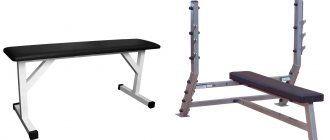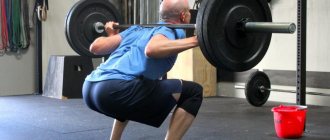- September 22, 2018
- Workouts in the gym
- Ekaterina Nikitina
The easiest way to increase your bench press is to do bench presses. The more you practice, the more experience you get and the better your form becomes. Correct technique, assistance from a trainer, and various variations of execution increase the effectiveness of the movement. You can't get better at something without doing it. To increase your bench press, you need to train hard and often.
Important specifics
The bench press is best done twice a week, for example on Monday, then rest for 3 days, and repeat on Friday. Sometimes trainers will advise switching up an exercise to increase the bench press. How to do it? Do push-ups, deadlifts and many other exercises. But this rarely works. While these exercises will strengthen the muscles you use on the bench, they do not train the movement itself. It's like trying to get better at the violin by playing the guitar. It doesn't matter if they are both string instruments. It's not the same thing. You need specificity.
How to increase your bench press? Stop thinking like a bodybuilder and start thinking like an athlete. Yes, you need to strengthen your muscles. But you also need to practice the bench press skill. How to improve your skill? More practice is the best way. Start with once a week, then do it twice in seven days.
How to increase your bench press
1) To protect your joints, include healthy vegetable fats in your diet and drink plenty of water.
2) Pain in the muscles after exercise is good, but if pain occurs during the exercise, stop doing it immediately. Don't risk your health, otherwise an injury can set you back many steps.
3) To increase strength indicators, it is necessary to reduce cardio loads, 3 times for 10 minutes a week and no more, otherwise this will negatively affect the increase in bench press.
4) Do not use the old school, in which the barbell falls just below the solar plexus, this is dangerous for the shoulders; at the lowest point the barbell should touch the bottom of the chest in the area of the nipples. At the same time, the elbows do not spread to the sides, but fall closer to the body.
5) Do not use the Smith machine often; it disables the stabilizer muscles, which are very useful for a regular bench press.
6) When tormented by the question of how to improve the bench press, from time to time use the dumbbell bench press, in this case, each hand is responsible for itself and eliminates the possibility of the stronger hand stealing part of the load from the weaker one, as when using a barbell.
7) Do not rush headlong into using complex programs; change them when progress has stopped and a period of stagnation begins.
 Don’t be afraid to increase the working weights; many people talk themselves out of lying down under heavy weights, like it’s too much, I won’t be able to handle it. Believe in yourself, motivate, because the biggest obstacles lie in your psychological attitude.
Don’t be afraid to increase the working weights; many people talk themselves out of lying down under heavy weights, like it’s too much, I won’t be able to handle it. Believe in yourself, motivate, because the biggest obstacles lie in your psychological attitude.
9) In heavy approaches, use wrist straps to protect yourself from straining your wrists, especially at an older age, this will protect you from pain in your wrists from constant stress.
10) Train your legs, remember, when you lift the barbell up, you put a lot of emphasis on the leg muscles, the stronger they are, the easier the repetition will be.
11) After pressing the barbell up for a second, hold it at the top, this will give the body the opportunity to prepare for the next approach and strengthen the muscles.
12) Use training to failure no more than once a month, otherwise the muscles can easily become overtrained. As soon as you feel that your technique is deteriorating, stop the exercise; it is better to take less weight than to get injured.
13) Before the bench press, warm up your shoulders well, improve their stretching; poorly warmed shoulder joints are a direct path to injury, especially their anterior bundle.
14) Find a good partner or coach who knows a lot about bench presses; development is good, of course, but smart advice on the side won’t hurt.
15) From time to time, instead of 1 working day for the bench press, perform the bench press 2 times a week, with 1 day being heavy and the 2nd day being moderate.
16) While performing the bench press, keep all the muscles of your body tense from your heels to your neck.
17) For a good bench press, you need strong triceps, pay attention to them and make them stronger with special exercises.
18) You should set small goals for yourself, be realistic, after achieving which, set a new goal, do not think that you will immediately overcome 100, 120 or 150 kg.
19) Keep a training diary so you can clearly see your progress without remembering everything in your head.
20) Train in gyms, not at home. Seeing how others lift more weight will automatically turn on your spirit of rivalry and competition.
21) Don’t be lazy to watch educational videos and read interesting articles about fitness and bodybuilding.
22) Improve your movement technique every time, learn to feel the muscle under load, there is no limit to perfection.
23) When you come to training, do you already feel lethargic and tired?! So it’s time to take pre-workout complexes - creatine, amino acids beta-alanine, arginine, glutamine, taurine.
24) To prevent the bar from slipping in your hands, use chalk or talc; it eliminates the possibility of your hands sweating during work, which improves your grip and makes it possible to finish the exercise efficiently.
25) If you feel unprepared for training, postpone it for 1-2 days, when you are ready to give it your all and catch up.
26) To improve your bench press, include heavy compound exercises in your training - squats, deadlifts, overhead presses, bent-over barbell rows. They increase strength and mass and of course make it possible to lift more weight under the bar.
27) Give yourself enough time for rest and sleep; if you are tired and sleep-deprived, forget about the growth of your pectoral muscles. For some, I’ll say that it’s more important for you to race on the computer until 2 a.m. or to create an athletic figure.
28) You should not always work on strength in the 1-4 repetition range, use a variety of schemes for 1-4 repetitions, 5-10 and 12-15.
29) To accustom your body to heavy weights, periodically remove the barbell and hold it above you without bending it at the elbows, without lowering it to your chest. The weight is 110-120% of the one-repetition maximum, you need to hold it for 10-15 seconds.
30) Raise the barbell up quickly, even when the weight is heavy and the barbell is moving very slowly, the impulse should be burning in your head to lift the barbell as quickly as possible.
31) Perform the press with a closed grip, eliminate the open grip, this can simply lead to the barbell falling onto your chest.
32) When lifting the barbell up, keep your buttocks tightly pressed to the gymnastic bench; tearing them off means breaking the execution technique.
33) Also, when lifting, try not to arch your lower back; this, of course, shortens the distance from the chest to the barbell, but also leads to microtrauma in the lower back. Then, having received a sharp pain while performing a deadlift, you will attribute everything to it, not realizing that the primary source of origin is the incorrect technique on the bench press.
34) After completing the approach, give the body a good rest; if necessary, rest for up to 5-7 minutes, after all, you are working with a basic strength exercise.
35) All the time during the bench press, focus on a certain point on the ceiling and strive to press the barbell there, this will help maintain more or less the same trajectory of the barbell, targeting a specific area of the chest.
36) Do not suddenly jump over the weights, gradually add weights preparing the muscles for the maximum weight, this is necessary for the body to warm up the muscles and set up all its functions for the final hard work.
37) Before training your chest, make sure your triceps are well rested. For those who train every day, eliminate the load on the triceps 1-2 days before the bench press, otherwise you will not be able to handle serious weights on the pectoral muscles.
38) The bench press should always be the first exercise in training until you are tired, fresh and full of energy, and your nervous system is not exhausted.
39) For a good chest workout, do not forget about the “rest-pause” method and “stop” training.
40) Having removed the barbell from the racks, first allow it to fully stabilize, eliminate rocking and movement, and only then lower it to your chest.
41) Once under the barbell, concentrate on the exercise, your goal is to press the barbell, close yourself off from all external factors, nothing and no one should distract you.
42) When doing a classic bench press, do not allow the bar of the bar to fall to the very top of your chest; in this case, the front deltoids will experience a colossal load, the result will be sprains and tears of the ligaments, which will lead to sharp pain in the shoulders when lowering the bar.
43) Strong and powerful back muscles help with the power press, adding stability and confidence in the execution.
44) Before lowering the barbell to your chest, bend it slightly forward, making sure that your shoulder blades are retracted and resting firmly on the gymnastic bench.
45) Eat enough protein, at least 2 grams. per 1 kg. weight, for a more complete and rapid recovery of muscle fibers after physical activity.
46) If you want to develop truly large chest muscles, stop bouncing the bar off your chest, lift the barbell up, not by rebounding, but by muscle force, this will allow you to engage more muscles in the work and load them better.
47) Attend training regularly, the result likes stability and passion for physical activity from time to time and randomly will not lead to positive results.
48) Do not lift weights at any cost, do not look at those who do more, the main thing is to train your muscles well, and not to show off in front of others.
49) Periodically start your chest workout with dumbbell flyes, this allows you to tire out your chest muscles while keeping your triceps fresh and not tired. Next, by switching to the bench press, you will complete your chest 100%.
50) If you are working on mass in the 8 rep range and have plateaued and can no longer increase the weight on the bar, switch to a strength program of 2-6 reps for about 4 weeks. After this, the muscles will increase their strength potential, which will help build on the success and take more weight for the same 8 repetitions. And the greater the weight, the more the muscle fibers are loaded, which means their volume increases.
I hope these tips will help reduce the relevance of the question of how to increase your bench press. Train and develop, become strong guys and charming girls.
Correct technique
How to improve your bench press results? First you need to master the technique. Correct lower position on the bench: vertical forearms, straight wrists, bar touching the middle of the chest. It is worth starting the lift from a short distance; the shorter it is, the easier it is to lift the weight. Proper technique improves the transfer of force from the chest and shoulder muscles to your forearms. This improves stability.
Proper execution also prevents injuries from occurring. Pressing with the wrong grip is ineffective and causes pain in the elbow or wrist. Pressing your elbows at a 90° angle will put pressure on your shoulders. Lifting your butt off the bench can hurt your lower back. This slows down your progress rather than speeding it up. How to increase your bench press? Proper technique and regular exercise are the keys to injury-free success.
How to improve your bench press results and increase your performance
Most athletes sooner or later face the fact that their bench press numbers no longer increase, because even if you have mastered the bench press technique in all its variations, there is no guarantee that the amount of weight you lift will constantly increase. There are many factors due to which this may not happen. Let's consider the factors that prevent you from improving your results, proven by experts.
First, as trite as it may sound, you need to train regularly, because if you want to get the maximum benefit from any particular exercise, you need to do it systematically.
Secondly, it is necessary to change the grip width from time to time. From all of the above, we understand that different types of grip involve different muscle groups; accordingly, periodic changes in grip allow you to maximize the development of all kinds of pectoral muscles - this will affect the full development of the bench press technique as a whole.
Thirdly, let's talk about nutrition. When gaining muscle, it is important to get the required amount of calories to allow your muscles to grow and develop. On average, this is about three thousand per day. Track your calorie intake to improve your bench press results. It's also worth keeping an eye on what exactly you eat, because if you consume enough calories, you risk gaining weight and gaining fat, which you will then have to burn.
A few additional exercises to improve your bench press results:
- Stand push-ups. The essence of the exercise is the same as in push-ups, only here we rest our hands not on the floor, but on stands, which can serve as anything when it comes to doing exercises at home (thick boxes, pots, etc.). The essence of the exercise is that there is no obstacle in the form of the floor - the press can be done deeper. For maximum benefit of the exercise, your hands should be placed at the same distance as when doing a bench press. 10 repetitions are enough.
- Negative press. To perform this exercise, you need two assistants and a barbell with a weight up to 20% more than your maximum. What's the point - you very slowly lower the barbell to your chest, and assistants help you return it to its original position. It is not advisable to perform more than 3 repetitions per approach. And you don’t need many approaches. 1-2 approaches with the same number of repetitions is quite enough.
There is no limit to perfection
No matter what level you are at, there are always problem areas that can be improved. Here is a short list of the most important technical points that will tell you how to increase your bench press:
- Lever. Hold the barbell low in your hands, close to your wrists. Squeeze using a full grip.
- The wrists should be straight. Keep the bar low to avoid bending your wrists and damaging them.
- Elbows. Keep them 75° from each shoulder. As you climb, the degree increases.
- Forearms - vertical to the floor, in a straight line from the bar to the wrist and to the elbow from all angles.
- Breast. Raise it toward the ceiling, squeeze your shoulder blades, and arch your back to stay in tension.
- Legs. Feet on the floor, legs bent at the knees at an angle of 90°.
- Rod path. A diagonal line from the middle of the chest to the shoulders, rather than a vertical line over the chest or shoulders.
How it was in Ancient Greece
Legend has it that Milo of Croton gained his strength by carrying a growing bull every day. How to increase the weight on the barbell in the bench press? Add weight to get stronger. Many people use the same weight for weeks, months, sometimes even years. In this case, there is no talk of any progress. But, nevertheless, there are people who do not understand why their skill is not developing. This is because you are not giving your body any reason to get stronger.
How to increase your bench press? The easiest way to get stronger is to add weight. This approach was invented back in Ancient Greece. According to legend, the wrestler Milo from Croton, when training for the Olympics, carried a newborn bull every day. The ox grew, and accordingly, the athlete’s strength skills and his ability to lift heavier weights gradually improved. Milo of Croton won the Olympics six times. And while it may just be a legend, now you know how to increase your bench press. We need to add weight.
Beginning of work
Let's draw some conclusions. Let's say you train your chest on Mondays, which is a universal day to train your chest.
You do the bench press first in your program and first do a warm-up set of 15 or so reps with a weight that gets your triceps burning after 12 reps. Then you add about 10 kilograms of pounds and do 12 more reps with that weight, with the last rep being quite heavy. You hang a couple more weights on the bar and plan to do 10 reps, but you only get 8 or 9.
You add more weight and hope to do 8, but you struggle with 5 and ask your training partner to help you do 2 more forced reps to get 7 reps. Your hands are all tired. They begin to tremble, the chest is tense, and yet you add more weight.
This set is the hardest and you do 1-2 good clean reps and another 1-2 with assistance. You decide to do one more set and barely press one rep, and then your partner does three reps of what is essentially a very heavy press just to keep the weight moving for you.
To be sure, you do another “pump set” with 10 kilograms removed from the bar, thinking that you will do 10-15 repetitions, but you only get 4 or 5. At this point, the bench press on a horizontal bench is completed, and you move on to the next exercise .
This has been your typical Monday for at least three years. Same weight. The same repetitions. Everything is the same, everything is the same. Feeling stagnant? Does this sound even remotely familiar? Most likely, yes, and that’s why something needs to be changed.
More strength - more muscles
Heavy weights stimulate your muscles to grow more. Repetition builds endurance. How to improve your bench press? If you doubled your bench press from 50kg for 8 sets to 100kg for 5 sets, how much could you improve? Test your strength in practice and find out the answer to this question.
What about push-ups? They will also be easier to do because stronger muscles require less effort. It takes longer for the chest and shoulders to become tired. you will be able to do more repetitions. Increasing bench press strength improves muscle endurance.
Progress on your favorite exercises
Each person naturally has different anthropometry (length of arms, legs, angles in the hip, knee joints and other parameters).
This should be used; it allows you to progress faster in individual exercises compared to other exercisers. If a person sees that the number of kilograms is rapidly increasing, he begins to devote more time to this movement, trying to increase the indicators again. The exercise becomes a special exercise that is loved by the athlete. It will be better if accelerated progress is observed in basic exercises :
- Bench press;
- Deadlift;
- Squats;
- Pull-ups;
- Dips;
- Bent-over barbell row.
Thanks to the inclusion of several muscle groups at once, they receive sufficient load necessary to increase their volume.
Isolated exercises (acting on 1-2 muscles) will not give such an effect. They can be used as an addition to the main training program.
Increase weight gradually
Do fewer sets with heavy weights. Add 2.5 kg each workout. Your bench will slowly increase to the heaviest weights you've ever lifted. This will become a challenging task. When you do this, you will program the muscles for heavier weights, more strength for more muscles.
Some people doubt the effectiveness of microloading. The goal is not to add weight once, but regularly. Even adding 1 kg to the weight lifted every week, and it will increase by 50 kg per year.
Injury Prevention
One of the biggest fears in bodybuilding is tearing the pectoral muscle off during the bench press. These usually occur due to insufficient warm-up, poor technique or form, too much weight, or overtraining, leaving you susceptible to injury. Technology will be our first topic.
Technique
Most traditional bodybuilding rules dictate that the grip on the barbell during the bench press should be fairly wide so that the elbows are away from the body, allowing for a full chest stretch and placing the load precisely on the pectoral muscles so that the triceps and deltoids are less involved in the movement.
This technique does not allow the use of maximum weight and puts the shoulder joint in an unnatural position. It also puts unnecessary stress on your pectoral muscles and leaves you open to tearing.
If you want to focus on power and strength, the grip should be narrower and the elbows should be 45 degrees to the body at the bottom of the range. Yes, the triceps will be used to a greater extent, but this position provides more driving force and is safer. The grip should be approximately slightly wider than shoulder width.
Slowly lower the barbell to the bottom of your pecs and lift it back up. You don't need to pause; just do it "touch and squeeze" style. And under no circumstances should you bounce the barbell off your chest—ever!
Warm-up
Even though this article is specifically about the bench press, chest day starts with incline presses. Why? To warm up and prepare for the bench press. Do a couple of warm-up sets of 15-20 reps with light dumbbells, and then move on to working sets.
Example:
- 2 warm-up sets of 15-20 repetitions with 10 kg dumbbells.
- 1 warm-up set of 10 reps with 15 kg dumbbells.
- 3 working sets of 6-8 reps with 25 kg dumbbells.
The weight shouldn't be so heavy that you struggle to complete the last reps of any set. We don't train to failure. The goal is to pump a lot of blood into the pectoral muscles and warm up the shoulder joints. Now it's time to move on to the bench press.
The program includes three sets of six reps for the bench press. These are working approaches. You should do warm-up sets first.
Let's say you want to bench press 100 kilograms. In the past you were doing maybe 95-97 kilos. First of all, even if you've already done one exercise, get used to doing your warm-up set with an empty bar.
Do 15-20 reps with a 20kg bar. After that, add two 10-kilogram weight plates to it and do eight repetitions. This is a warm-up with 40 kilograms.
Since you've taken a week off and will be performing the exercise with a new technique, you need to take the time to do it correctly. Starting over again is how you can sum it up.
Adding weight
Replace 10 kilogram pancakes with 15 kilogram ones. Perform three sets of six repetitions with this weight. Don't go to heavier weights or add reps. You can do so much more, right? But it's not that.
The point is to relearn how to bench press so you can become stronger than ever before. Next week you'll add another 5 pounds per barbell and again perform three sets of six reps.
When you reach around 70kg, add another warm-up set with 60kg after the 40kg set and do four reps with 60kg.
Continue adding five kilograms each week until you begin to have difficulty completing six reps on all three sets. I think you will reach around 80 kilograms when this happens.
Next week, add five kilograms to the barbell and do five reps for three sets. On the next one, add five more and again do three sets of five reps. At some point you won't be able to do five reps.
If you only do four reps, that's okay. Do three sets of four repetitions. Once you have three sets of four, move up to three sets of three reps for a couple of weeks.
Finally, do three sets of two reps. At this stage you should be using around 95-97kg. Next week try a weight of 100 or even 105 kg.
As the weight increases, it is important to add a few more warm-up sets. They don't have to be heavy, but they will help you get comfortable with heavier work sets. Therefore, such sets are called “acclimatization”.
After the first two or three sets with a barbell weighing 40 kg. add a set of 60kg and do four reps. Add another 10 kg and do two repetitions. Add 10 more and do just one rep. This will help you get used to heavier weights without burning you out in the process.
Don't get overwhelmed
The basic premise of the routine is progressive overload, which means you're putting too much stress on your muscles each week. You only need to add a small amount of weight to the bar on a weekly basis. It is this progressive overload that forces the body to grow so that it can adapt to ever-increasing stress. When your eyes are directly under the bar, your shoulder blades are squeezed together, your chest is held high and puffed out, your back is slightly arched, and your feet are firmly planted on the floor, this gives you a good base for pushing forward.
The bench press is one of the best upper body exercises you can do because when done properly, it not only trains your chest, but also your shoulders, triceps, and even your legs. Every chest or push workout should include at least a few sets on the bench. However, like other major lifts such as the deadlift, the bench press is actually a technical exercise. If you don't know what you're doing, you'll quickly hit a muscle plateau, which is not only frustrating, but can also cause injury when you try to break through it, compromising technique and weight.
Rest between sets
Rest five minutes between heavy sets. This way you can do more repetitions. How to increase strength in the bench press? Reducing your rest time will make you sweat more. But they won't increase your bench press. The optimal time allotted for rest is 5 minutes. It's a trade-off with increasing returns. Keep your workouts short but with tough sets.
However, you don't need to rest that long between easy sets. Knowing these simple rules, you will learn how to increase your results. The bench press is an exercise that can always be improved.
Useful tips
How to increase weight on bench press? If you're an experienced weightlifter, you know the importance of mental preparation for heavy lifts. You've no doubt seen powerlifters go through what sometimes seems like a ridiculous satanic ritual before attempting to lift a load, but did you know that such self-programming is scientifically proven? Athletes who are determined to succeed are said to experience an 8% increase in strength.
It is also believed that distraction significantly reduces force production. It is important to concentrate and not talk. Some may sing songs, others may visualize victory. They all have their own tricks that contribute to a successful lift and increased strength during the lift. If you are new to weightlifting (less than a year), this advice does not apply to you. However, if you are an experienced lifter, you may find this useful.
You might be surprised how much depends on the sequence of exercises. Some athletes do not see the bench press as a priority exercise and many use it as the last exercise in their training. They'll usually start with dumbbells, then maybe move on to machines, and finally come to the bench to do a few sets. However, the order in which you perform the exercises has a significant impact on your strength and overall performance for each exercise.
The most powerful workouts start with the most powerful sets, such as the bench press. Workouts always start with big, compound lifts like bench presses, deadlifts, military presses and squats, and then move on to isolation exercises like dips and so on. Start your workout with the most difficult one and you are most likely to make progress.
Tip #3
The training process must be structured in such a way that between training the pectoral muscles (the first and second days), the break is at least three days. The following diagram can be used as an example:
- First chest workout.
- Leg training.
- Second chest workout.
- Shoulder and back workout.
It should be remembered that the development of the body should be symmetrical and harmonious, so you should not focus on one muscle group for a long time. The goal of the training is the full and comprehensive development of the body.
And also read: Exercises for sculpted abs → How to make your shoulders wider? How to pump up a wide back? How can a man achieve a V-shaped figure?
More weight - fewer approaches
The heavier the weights and the more sets per workout, the less often you can train a muscle group. When training at sufficient intensity (focusing on lifting heavy weights), the optimal frequency is around 40-60 repetitions every 5-7 days. Currently, training each muscle group 2 to 3 times per week is the norm, and while this is worthwhile (if the volume is programmed correctly), it is not necessarily more effective than training each muscle group once every 5-7 days at the correct volume .
The bottom line is, when it comes to increasing muscle mass and strength, research shows that proper training volume appears to be more important than frequency. If you do less than the optimal amount, you risk losing some of your success. If you do more, you'll likely overtrain. To increase speed, change the working width. Powerlifters have been using different grip widths for years and use them as an effective method of increasing bench strength. Research has shown that a wide grip (a few inches wider than shoulder width) emphasizes the larger prime mover muscles (the pecs), while a narrow grip (right shoulder width or slightly narrower) emphasizes the smaller muscles.
Multi-repetition bench press training technique
The number of strength sports and sports federations is increasing year by year, today almost every lover of “iron” sports can find a sport to their liking, although 20 years ago this choice was very limited and consisted of only a few types: weightlifting, powerlifting and bodybuilding . Now the choice is huge and an amateur athlete can train and perform exclusively in a form such as the bench press, without training deadlifts or squats, due to injuries or the choice of other strength exercises. Along with the bench press, it is possible to do deadlifts or train grip strength, as in arm lifting, or perform pull-ups on a horizontal bar, as in “workout.”
Recently, in the practice of strength sports, such a type as the “national bench press” or “Russian bench press” has appeared; competitions are held under the auspices of different sports federations and their rules differ slightly. The meaning of these types is to press a barbell of a certain weight for the maximum number of repetitions, and, consequently, the development of special strength endurance.
In connection with changes to the manual on physical training and the appearance in it of the exercise bench press of a 70 kg barbell for the maximum number of times, the question arises, how to train a high-repetition bench press and develop special strength endurance? How often to train? With what weight and how many approaches to the bar should I do? It should be noted that there are no specific recommendations on training methods in the sports literature or on the Internet; one can only rely on studying the training methods of other sports.
The first thing you need to understand is what the multi-repetition bench press is most similar in structure to. On the one hand, the exercise is performed with external weights, as in kettlebell lifting, on the other hand, the duration of its implementation cannot take ten minutes, but ranges from 30 seconds to 1-1.5 minutes, during which the body gives all its best. This exercise, in its effect on the body, is most similar to sprinting at a distance of 400 meters (in the practice of athletics, running at this distance requires, first of all, the development of such a quality as speed endurance). This is also proven by the practice of performing multi-repetition bench presses: when performed, depending on the weight of the weight and the level of training of the athlete, complete muscle “failure” is achieved in the range of 17-40 repetitions, and the speed of performing the last repetitions is significantly lower than the initial ones, like the last meters of a running distance. 400 meters.
Let's look at the means and methods of training runners and draw an analogy for the high-repetition bench press. According to S. Mikhailov (2004), running a distance of 400 meters is work of submaximal power, and the basis for the energy supply of this muscular work is glycolysis (the breakdown of glycogen outside the mitochondria), which leads to severe acidification of the blood and, as a consequence, to the inability to continue working at a given power level (last meters of bench press distance or reps). The deployment time of the glycolysis mechanism is 20-30 seconds and lasts, depending on training and other factors, up to 4-5 minutes, therefore, training loads should be so that in a given time interval they reach muscle “failure” or a state close to it, until a significant decrease in the level glycogen in working muscles. Rest between repeated approaches can be 5-6 minutes until lactate in the muscles decreases significantly. The same is confirmed by M. Hosny (1995) in his dissertation: he divides training in the submaximal power zone into lactate anaerobic power (load time 20-30 seconds, rest between series 6-10 minutes, number of series 3-4) and lactate anaerobic power capacity (load time 60-90 seconds, rest between series 5-6 minutes, number of series 10-15). For a bench press weighing 70 kg (exercise No. 8 from NFP - 2009), the second range is preferable, although in the weight category up to 70 kg, with a sufficient level of preparedness, you can only perform 21 repetitions in 30 seconds, which will correspond to 100 “points”.
What exercises, besides the bench press, and how often should you do them? Let us turn to the methodology of training runners; the basis of their training at the stage of in-depth specialization is running at various distances: up to 80 meters, 80-300 meters, running 300-600 meters, special exercises, exercises with weights (squats, step-ups), jumping in all kinds of variations, cross-country running and exercises from other types of athletics, performed with an intensity of 81-96%.
Let's consider these means in relation to the high-repetition bench press: running up to 80 meters for runners corresponds to working with a barbell within 4-6 repetitions in the bench press and develops maximum strength in this movement, the next repetition range from 8 to 20 is work with high intensity for developing power , followed by the longest rep range of 20 to develop specialized endurance. Special exercises include exercises of the muscles involved in the bench press: flyes with dumbbells lying on a bench for the chest, bench presses with a medium grip and push-ups on parallel bars for the anterior fascicles of the deltoids and triceps. Runners' jumps will correspond to high-speed bench presses or "push-ups" with a jump at the end of the movement to develop explosive power.
Such training leads to a significant decrease in glycogen and creatine reserves in muscles, creatine reserves are restored almost completely in 5-6 minutes, glycogen reserves according to S. Mikhailov are restored in 24-36 hours, and muscle contractile structures damaged as a result of training in 72-96 hours . In accordance with the recovery period, a training cycle is built that takes into account supercompensation, which also takes time, taking into account the individual characteristics of the body.
From the above, we can give specific recommendations on the means and methods of training the multi-repetition bench press: training should be aimed at increasing absolute and explosive strength, as well as special endurance, the training range is from 3-6 repetitions to 20-30 repetitions in a competitive exercise with an intensity of 80 -97 percent. Training should be carried out no more than once every 2-3 days, and “impact” training no more than once every 5-7 days; if necessary, the rest time can be increased. The intensity of training should alternate from high to medium or low. In addition to the main exercise, it is necessary to perform auxiliary exercises with dumbbells, a barbell or your own weight to strengthen weak points in the press if there are any, for example, the last third of the movement with weak triceps. It is recommended that your training include performing exercises with maximum weights to develop maximum strength and performing exercises with moderate loads at maximum speed to develop explosive power.
These recommendations should lead to success in training the high-repetition bench press.
Literature:
1. Mikhailov S.S. Sports biochemistry: textbook / S.S. Mikhailov. – M.: Soviet Sport, 2004. – 220 p.
2. Manual on physical training in the RF Armed Forces, as amended. – St. Petersburg: VIFK, 2013. – 200 p.
3. Hosni M. Bioenergetics of repeated muscle work and the effectiveness of interval training in sports: abstract. dis. ...cand. ped. Sciences / M. Hosni. – Moscow, 1995. – P. 11-13.
One of the important upper body exercises
The bench press is one of the most important upper body exercises, not only is it important for the development of the upper limb muscles, but it is also an exceptional strength builder. Many people think it's just a chest exercise, but it works your triceps, shoulders, back, and even your glutes. This is a difficult move that can even be dangerous if you make a mistake. If you're benching without worrying about how you're doing it, you may need to take time to step back and focus on improving your technique.
Wear the right shoes
Your feet are your base. They connect the body to the ground, so what you put on them, even when benching, matters, often crucially. As a rule, shoes are purchased based on personal preference, but it is better if your feet are wearing sports shoes that will have good grip on the ground. Weightlifting shoes can be used because they have a raised heel, which makes the athlete feel like their feet are better connected to the ground. They also have a really grippy bottom to keep your feet from slipping. Other people, however, prefer to use shoes with flat soles. Regardless of your choice, try to constantly monitor comfort and safety while exercising.
A common mistake is that many athletes do not use flooring. Pressing into the rack and squeezing your chest and triceps is a given. But remember that the bench press is the pressure that lifts the barbell off the ground. With that said, applying deadlifts to the ground will make your lift stronger. On each push, press your feet into the floor. This doesn't mean you need to lift your hips and make the movement dangerous. Create solid tension through your body and reap the benefits of strength. The strength of your lift always comes down to how strong you are to begin with. A good mindset can help you make the progress you want when it comes to a strong (and safe) bench press.











